The WaterSense Current Summer 2013
Issue XXVII, Summer 2013
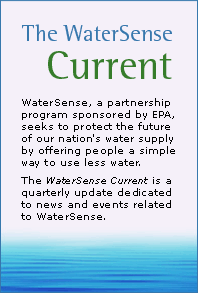 |
In This Issue: |
WaterSense Labeled Products Save Americans Nearly $9 Billion
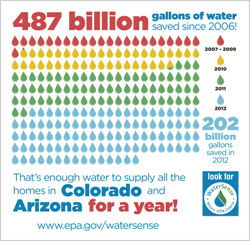
Spring is often a time for tackling those tough indoor chores. But you can also save water and money outdoors with a little sprinkler spruce–up this season.
Consumers who invested in WaterSense labeled products have saved a total of $8.9 billion in water and energy bills and 487 billion gallons of water since the program's inception in 2006. That's the amount of water needed to supply all the homes in Colorado and Arizona for a whole year! In 2012 alone, WaterSense labeled products helped save more than 202 billion gallons of water.
By the end of 2012, nearly 8,600 different models of WaterSense labeled toilets, faucets, faucet accessories, showerheads, flushing urinals, and weather-based irrigation controllers were on the market. In addition to water savings, these products have helped consumers save 64.7 billion kilowatt hours of electricity needed to heat, pump, and treat water, or the amount of electricity needed to power 6.1 million homes for a year. Saving that amount of energy helps eliminate 24 million metric tons of greenhouse gas emissions—the equivalent of planting nearly 606 million trees.
These savings would not be possible without the more than 2,700 WaterSense partners, including utilities, government agencies, nonprofit organizations, manufacturers, retailers, distributors, builders, and irrigation professionals who have joined with EPA to help promote the WaterSense label and spread the word about the importance of water efficiency.
Builder partners, in particular, had built 221 WaterSense labeled new homes by the end of 2012. With these single-family homes saving as much as 50,000 gallons of water per year and $600 annually on utility bills compared to traditional homes, consumers who invested in a WaterSense labeled home have saved a combined 11 million gallons of water per year. Starting in 2012, multi-family units can now earn the WaterSense label as well, so apartment and condominium owners and renters can get in on the savings.
To keep spreading the word about water efficiency, WaterSense had nearly 10,000 Facebook fans and Twitter followers by the end of 2012. Hosting its first Fix a Leak Week “Twitter party” on March 12, 2012, WaterSense saw #fixaleak trend second in the United States, and #fixaleak was tweeted by WaterSense and its partners more than 1,000 times.
Learn more about WaterSense's milestones.
When in Drought, Use WaterSense
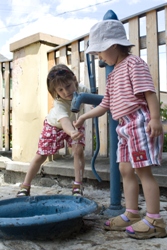
Drought can hit anytime, anywhere, not just in the drier parts of the country. In fact, in September 2012, 65 percent of the United States was experiencing drought. If drought is affecting your area, it's important to save water supplies for those who need it most. You can do your part to help your community—but keep your curb appeal and comfort—by following a few simple savings tips from WaterSense:
- Follow the rules. If your community has taken the step of restricting water use, it's to ensure that water is available for critical community needs such as firefighting, health care facilities, and other important functions.
- Check for leaks. Easy–to–fix leaks could be robbing nearly 1,000 gallons of water per month from your home. Make sure your faucets, toilets, showerheads and sprinkler systems are not wasting water.
- Consider an upgrade. If you're thinking about a bathroom update, now is the time to replace water–wasting fixtures with high–performing, WaterSense labeled models, which are independently certified to use at least 20 percent less water and engineered to perform as well or better than standard models.
- Take a sprinkler break. Grass doesn't have to be bright green year-round. It's natural for your landscape to look a little brown during summer's hottest months. You can cut back on watering and reduce stress on your local water supplies without compromising the health of your lawn. If you have a clock timer irrigation system, consider upgrading to a WaterSense labeled irrigation controller, which acts like a thermostat for your system by telling it when and how much to water. In the future, consider plants that need less water and are better suited to your local climate.
- Go the extra mile. If you've done all you can to be water–efficient, you can get creative by reusing water from showers, dish tubs, ice buckets, or pets' water bowls on flowers.
And when the rains return, your water-saving ways don't have to go away. Avoiding wasteful habits throughout the year not only helps you save water, energy, and money—it will help your community be better prepared during future drought periods. For more information, check out other ways to start saving or visit the Drought & WaterSense Web page for up–to–date drought information.
Learn From the Water–Smart Landscape Photo Contest Winner

Gino Piscelli's winning photo shows how
beautiful water–smart landscapes can be.
In response to WaterSense's recent Water–Smart Landscape Photo Contest, more than 60 home and business owners, landscape designers, and irrigation professionals submitted nearly 100 images demonstrating how beautiful and efficient water–smart practices can be. Consumers chose winners from the 10 finalists posted to the EPA WaterSense Facebook gallery ![]() in April 2013. WaterSense recently caught up with the Water–Smart Landscape Photo Contest first-place winner, Gino Piscelli from Mississauga, Ontario, to learn the story behind his submission.
in April 2013. WaterSense recently caught up with the Water–Smart Landscape Photo Contest first-place winner, Gino Piscelli from Mississauga, Ontario, to learn the story behind his submission.
Piscelli serves as a technical analyst for the Region of Peel's Fusion Landscaping Program, which helps homeowners transform their lawns using eco–friendly and low water–using plants. His winning photo depicts a lawn owned by one of five homeowners participating in the program's Fusion Gardens pilot study.
As part of the study, Piscelli and his team monitor the water use of participants' landscapes and compare usage rates to surrounding lawns'rs traditional water requirements. Prior to its transformation, the landscape depicted in the winning photo required ongoing maintenance through watering, mowing, and weeding in order to keep it green and lush. In 2010, after a 10–day makeover, it was flourishing with drought–tolerant plants that thrive in direct sunlight and covered in mulch to reduce evaporation. As a result of this effort, the homeowner is expected to save 800 gallons of water per Mississauga's 120–day irrigation season, or more than 6 gallons per day.
Following is a summary of WaterSense's interview with Piscelli, who shares behind–the–scenes design techniques and helpful tips for green thumbs looking to use less blue.
Q: Why did the homeowners want to pursue a water–smart landscape design?
A: They wanted to become more environmentally friendly without having to forfeit the beauty of the traditional garden. More and more, homeowners are looking for ways to increase their properties' sustainability, and some have realized the cost, time, and maintenance factors required to keep a lawn lush is becoming outdated.
Q: What water–smart features were incorporated?
A: We used compost to improve the soil quality and selected perennials, shrubs, and trees that would showcase the property''s features—Diablo Ninebark, Salvia, Barberry, Russian Sage, and Flowering Quince. All of these plants flourish in the landscape's full–sun setting, and the 4–inch layer of mulch we used on top helps the soil retain moisture even on summer's hottest days.
Q: What should homeowners look for when selecting low water–using plants?
A: Identify the light exposure on your property and select plants that are native to your area. Many homeowners purchase plants based on beauty, but they should check a plant–s tag for its sunlight and watering needs to ensure their landscape and climate is a good fit. Homeowners often put a water–efficient plant in the wrong place and must then continue watering it to compensate for its improper location.
Q: What–s the most common way homeowners waste water outdoors?
A: Take a look in any residential neighborhood throughout the summer, and you will see homeowner after homeowner watering their lawns. Whether it's hand watering, a sprinkler, or an in-ground irrigation system, all these homeowners have the same desire—to keep their grass green during rising temperatures…which is not a sustainable action.
Q: What maintenance tips do you give homeowners for their water–smart landscapes?
A: The first four to six weeks after planting are crucial in helping plants become established. This should be the only time your garden will require consistent watering to help the root system develop. Once established, your landscape should only require watering during long periods of low precipitation. Additional maintenance might include adding a 1–to 2–inch layer of mulch each year to help retain moisture during peak summer days.
Learn more water–smart landscaping tips and check out WaterSense's new, extensive Water–Smart Landscape Photo Gallery for design inspiration in your region of the country.
Lone Star State Landscape Saves 12 Million Gallons Using WaterSense
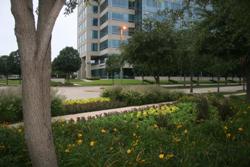
The Granite Park office complex landscape
reduced its irrigation water use by about 40 percent.
Office buildings account for approximately 9 percent of U.S. commercial and institutional facilities' total water use, with landscaping taking up nearly one–fourth of office buildings' water use. With the help of a landscape professional certified through a WaterSense labeled program, the Granite Park office complex in Plano, Texas, reduced its irrigation water use by approximately 40 percent and is winning awards in the process. Read the third in a series of case study highlights from EPA's WaterSense at Work: Best Management Practices for Commercial and Institutional Facilities.
Certified professional Bruce Birdsong is the president of Precision Landscape Management, which assumed grounds maintenance duties at Granite Park's 372,000-square–foot landscape in 2008. After conducting an irrigation audit that revealed room for water efficiency improvements, Birdsong and his staff replaced the landscape's clock timer irrigation controllers with weather-based models to tailor watering schedules to onsite weather conditions.
The landscape management firm also initiated routine system inspections to ensure Granite Park's continued water savings. Maintenance measures included replacing broken sprinkler heads, ensuring adequate coverage, checking the system for leaks, and verifying proper controller programming and scheduling. In addition, rain and freeze sensors were installed to prevent watering at unnecessary times.
Within one year of the irrigation system upgrades and operational improvements, the Granite Park office complex saved nearly 12.5 million gallons of water and $47,000. Beyond improving the bottom line and saving water, Granite Park earned credits toward the complex's LEED® Gold certification. Two buildings in the complex, Granite Park I and II, are now LEED Gold certified.
To learn how other types of commercial and institutional facilities are reducing their water use, read WaterSense at Work's case studies collection.
Partner Profile: American Standard Brands
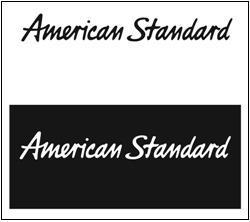
American Standard Brands, a 2012 WaterSense Manufacturer Partner of the Year, hit the road for nine months, literally driving demand for water efficiency along the way. The company's cross-country Responsible Bathroom Tour![]() epitomized the meaning of partnership, collaborating with more than a dozen utilities across the country to promote local rebates.
epitomized the meaning of partnership, collaborating with more than a dozen utilities across the country to promote local rebates.
The nine-month tour provided hundreds of demonstrations of WaterSense labeled toilets, faucets, and showerheads. For those who missed the water-efficient bathroom on wheels, a free Responsible Bathroom smart phone application provides water conservation decision-making tools, facts, and a cost-savings calculator for different plumbing products and water-smart behaviors.
When American Standard wasn't in the driver's seat promoting water efficiency during 2011, it was promoting an easy–to–install WaterSense labeled toilet. Dubbed the “no tools” toilet, American Standard's SAVER™ toilet can be installed with simple hand tightening; everything needed to install it comes right in the box. The simple, illustrated instructions allow even novices to install a WaterSense labeled toilet do–it–yourself style.
In March 2011, in conjunction with WaterSense's Fix a Leak Week and St. Patrick's Day, American Standard joined two-time WaterSense Promotional Partner of the Year Cobb County Water System and Georgia's first Licensed Green Plumber® to sponsor a “Go Green and Save Green” workshop, educating consumers on how to check for leaks and install water–efficient products.
Through its partnership with the Green Education Foundation, American Standard has also helped develop a K–12 curriculum to teach students about sustainable building, ecology, and the environment. In addition to students, the company supported both consumer and professional audiences with its light–hearted but informative Professor Toilet blog![]() . The nearly 20,000 unique visitors to the site in 2011 are a testament to how a blog offering a little humor and a lot of great information can make an impact.
. The nearly 20,000 unique visitors to the site in 2011 are a testament to how a blog offering a little humor and a lot of great information can make an impact.
Learn more about American Standard Brands![]() and its efforts to promote WaterSense.
and its efforts to promote WaterSense.
Partner Profile: KB Home
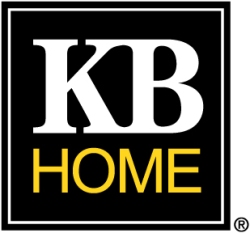
As a two–time recipient of the WaterSense Builder Partner of the Year award, 2012 winner KB Home knows the importance earning the WaterSense label in new construction. In 2011 alone, KB Home constructed nearly 100 WaterSense labeled new homes in five communities in California, Texas, and Florida.
Beyond the labeled homes themselves, KB Home promotes WaterSense labeled products to homebuyers throughout its models. To ensure that its homes are water–efficient outside as well, KB Home collaborated with Hunter Industries to develop a weather–based irrigation system option for homebuyers designing new homes at the KB Home Studio. It also encouraged the landscape product manufacturer to pursue the WaterSense label for its weather–based irrigation controllers.
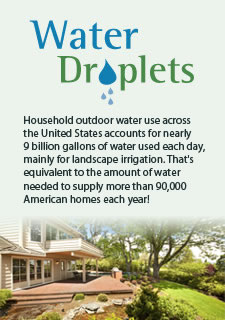
KB Home doesn't just offer WaterSense labeled products to homebuyers; the company goes above and beyond by communicating the importance of the WaterSense label to industry stakeholders, customers, and its employees. As part of their new–hire orientation, all KB Home employees must take a “My Home. My Earth.” sustainability training course. Employees must also pass a certification test on the features and benefits of WaterSense labeled products and new homes. KB Home employee groups, such as sales counselors and the KB Home Studio team, complete additional training to help them explain the benefits of water–efficient landscaping packages, weather–based irrigation controllers, and hot water recirculation systems to homebuyers.
In addition to being an advocate for the WaterSense label, KB Home expanded its sustainability focus by developing the KB Home GreenHouse™![]() with Martha Stewart—a concept home designed to achieve net-zero energy and extensive resource efficiency. The net-zero concept became a reality in 2011 with the completion of KB Home ZeroHouse 2.0 models in Tampa, Florida, and Austin and San Antonio, Texas. Both Texas homes earned the WaterSense label, in addition to being energy–efficient. These net-zero energy use options are now available at select communities across the country.
with Martha Stewart—a concept home designed to achieve net-zero energy and extensive resource efficiency. The net-zero concept became a reality in 2011 with the completion of KB Home ZeroHouse 2.0 models in Tampa, Florida, and Austin and San Antonio, Texas. Both Texas homes earned the WaterSense label, in addition to being energy–efficient. These net-zero energy use options are now available at select communities across the country.
Learn more about KB Home![]() and its efforts to promote WaterSense.
and its efforts to promote WaterSense.




